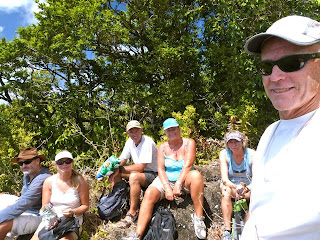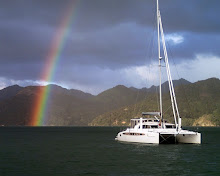During our overnight sail from Niuatoputapu to Neiafu in the Vava’u Island
group of Tonga, we were challenged by winds with a significant, southerly
component forcing us to point “Blue Rodeo” as close to the wind as
possible. Throughout the first day, we did well and managed to gain a few
miles of progress east of our rhumb line in anticipation of an even more
southerly wind shift during the night. Our strategy worked well until a
west-setting current conspired against us forcing us to either tack back
and forth or motor sail to make our desired landfall. We opted for the
latter and used our trusty diesel engine for the last 2 ½ hours of the
passage. After following our electronic chart guidance and range markers
ashore, we entered the protected harbor at Neiafu and tied to a mooring
ball near the Aquarium restaurant, a popular cruiser hang-out.
Once we were moored and our engine shut down, Anne noted a strong, acrid
smell coming from our engine room. Mark’s initial inspection confirmed
the odor but revealed nothing amiss in terms of overheated equipment,
hoses or wiring. Later that day however, after opening the sealed box
containing our two engine starting batteries, he was horrified to find
that the main engine battery was extremely hot and had boiled out most of
its acid electrolyte. A long, messy cleanup ensued before the toxic
solution was thoroughly neutralized and the battery removed from the
system. Clearly the battery had been subject to a sever overcharge so,
over the next few days, Mark would spend hours attempting to determine the
cause. Fortunately, “Blue Rodeo’s” electrical system has adequate
redundancy so, despite ruining the main engine start battery, were could
interconnect portions of the system in order to be fully functional.
Needless to say, while we had several enjoyable days getting to known the
town of Neiafu, Mark’s brain would remain rather preoccupied with the
mental trouble-shooting and solution seeking for our problem. Once again,
cruising has defined itself as doing boat repairs and maintenance in
exotic parts of the world.
Neiafu, Vava’u is a quaint little place with an eclectic assortment of
shops, markets and restaurants that cater to international tourists, many
of whom have come for the opportunity to watch and swim with the Humpback
whales that come here each year to give birth and nurture their young
before heading to the colder waters of the Southern Ocean. We had, in
fact, already seen several whales frolicking in the waters around us.
While in Neiafu, we had a chance to do some re-provisioning and indulge
our cravings for cheeseburgers and fish ‘n chips. One evening, we joined
a dozen of our cruising friends for dinner ashore and watched, on
satellite TV, a football (rugby) game between Australia and New Zealand.
Since our group was composed of a nearly-equal mix of “Aussies” and
“Kiwis”, the evening proved to be great fun as everyone teased each other
over their nationalistic rivalries. For us, not knowing anything about
the sport of rugby, it was an education. We have to admit though that we
still don’t understand much of the game.
It soon became clear that Neiafu is one of those places that cruisers
refer to as a “vortex” that can suck sailors in due to the lively social
scene and comfortable amenities. Resisting the urge to hang out for a
longer period of time, we left the port in company with friends on the
yachts” Malarkey” and “Awaroa” and sailed to a beautiful bay called Port
Morelle where we would spend several days snorkeling , SCUBA diving and
exploring two sea caves that are a short distance away. One, Mariner’s
Cave, requires swimming about 30 feet, 10 feet below the surface to gain
entrance. Once inside the cave, visitors are treated to the amazing sight
of the water-sculpted cave walls and ceiling illuminated by light
reflected off the sea floor from the outside. With passing swells, air in
the cave is compressed causing a pressure change that is felt in the ears.
When the swells subside, the resultant pressure drop causes the cave’s
air, thick with moisture, to momentarily produce fog…quite an experience!
Another cave, about a mile away, can be entered by dinghy but features
even more dramatic lighting and is a hide-out for enormous schools of bait
fish that swirl and glide in iridescent clouds. Swimming through the
schools would cause to fish to momentarily part company then rejoin the
mass once the human intruders swam away. This was a sight that made us
wish we’d have invested in a good underwater video camera. Words just
don’t seem adequate to express the splendid beauty of the sight.
From Port Morelle, we moved on to other islands in the group where we
found more breathtakingly beautiful scenery, both above and below the
surface of the water. While anchored at the island of Vaka’eitu, we
snorkeled on magnificent coral reefs and did a night SCUBA dive with
friends Trevor and Johanne from the yacht “Malarkey”, on an area known as
the “Coral Gardens”. Night dives are always a bit surreal with the limits
of visibility confined to our flashlight beams. There is also the
tendency to get a bit “psyched-out” wondering what big creatures may be
lurking just beyond the limits of our lights. The rewards though are
quite special and, in the case of this dive, we were treated to views of
incredibly colorful coral formations and fish of all shapes and sizes.
The high points were seeing several orange and black Fire fish, close
relatives of exotic Lion fish, and dozens of cute Clown fish (think Nemo)
hiding within the tentacles of huge sea anemones.
While at Vaka’eitu, we also went one evening to Lape Island and attended a
fund-raising feast put on by the island’s 39 residents. Over the years,
they have used the feasts to raise money to build a small concrete wharf
and are now hoping to add a floating dock to it so as to make landing on
the island safer. All 50 available spots at the feast were booked, mostly
by cruising sailors, and a delightful time was had by all. We dined on
roast pig, complete with head and snout and other assorted Tonga
specialties. The high point of the event was interacting with the
island’s friendly people, especially the children. As we dined, the
children sang songs with such charm and sweetness that we couldn’t help
but be moved. It is clear that the tradition of friendliness remains in
modern Tonga and we hope that those that follow our path in the future
will find that it has not changed for the worse. While we travel across
the immense Pacific, we wonder how it must have been 30 or 40 years ago
when few cruisers made the crossing and the native people’s lives were
even less affected by the outside world. Again, we feel so fortunate for
having this experience now because change, no doubt, is inevitable.
Saturday, September 22, 2012
Tuesday, September 4, 2012
Niuatoputapu, Tonga
From The Samoan Island of Savai’i, we pointed “Blue Rodeo”
south, for the first time in many months, and sailed to the tiny island of
Niuatoputapu in the northern portion of the Kingdom of Tonga. Our landfall, shortly after sunrise, treated
us to an impressive view of a cone-shaped, volcanic island just northwest of
Niuatoputapu itself. It clearly served
as a reminder of what geological processes created these tropical islands. In fact, volcanic activity continues to this
day and our charts indicate the presence of undersea mountains that rise from
the depths to just hundreds of feet below the surface and occasionally spew
steam, ash and even pumice into the atmosphere.
We imagined how frightening it might be to be sailing peacefully along
and suddenly be at “ground zero’ during one of the eruptions.
Like many of the Pacific islands, Niuatoputapu (known by
cruisers who have trouble with the pronunciation as “New Potatoes”) is
surrounded by coral reefs and requires careful navigation to safely approach
the harbor off the main village. We
found the entrance easy enough and were soon anchored off the village’s town
wharf with our yellow “Q” (quarantine flag) hoisted to our mast’s starboard
spreader. While we waited for the
arrival of the immigration, customs and health and agriculture officials we were
joined in the anchorage by our friends on the yachts “Malarkey” and “Awaroa”
who had also sailed from Samoa. We also
received a radio call from a friendly local woman named Sia who welcomed us to
the island and offered to help with any services we might need and suggested
that we join her and her family ashore the next evening for a pot luck dinner.
After a short while, three officials arrived at the wharf in
a rather rusty and worn-looking pickup truck.
Mark ferried them to “Blue Rodeo” with our dinghy and we completed the
clearing-in process. Despite the
condition of their vehicle, the officials were nicely dressed in traditional
Tongan business attire with long skirts for the women and similar, ankle length
skirts for the men. Around their waists
were woven wrappings made from strips of palm leaves. Having completed the paperwork aboard our
boats, we all went ashore with the officials where we were given a ride in the
bed of their truck to their offices where we could change US dollars for their
currency and pay our check-in fees. The
ride proved interesting as we were afforded the first opportunity to see how
the island’s residents lived and what efforts were being made to rebuild the
villages after a deadly tsunami destroyed most of the near-shore structures in
2009.
During the next few
days we would learn in detail how a nearby earthquake produced a 30’ high wall
of water that swept ashore killing 9 people and creating widespread
destruction. Even though it had been
several years since the tsunami, many were still living in shacks made from
salvaged materials while, with the help of foreign aid, new villages were being
built on higher ground. Even though the
modest new homes were being offered as free replacements to families that had
lost everything, some were unwilling to leave their original land, choosing
instead to live in whatever they could scrape together.
Our pot luck dinner, where we cruisers provided most of the
food, with Sia, her husband Nico and their 4 children proved interesting as we
learned more about the way they lived, the tsunami and the island culture. It was made clear how needy many of the
island’s 870 residents were and, before sailing on, we all brought ashore gifts
of food items and anything else we could spare.
Our days on Niuatoputapu passed quickly and were filled with
socializing, touring the island on rental bicycles guided by one of Sia’s sons,
hiking to the top of the island’s central, jungle-covered mountain and
snorkeling its surrounding reefs. Sadly,
the near-shore reefs were still showing the impact of the tsunami damage with
most of the coral in rather bad shape.
We can only image that it will take many years for them to recover from
the natural disaster.
Prior to leaving the island we joined most of its residents
for their Sunday church service where we were truly impressed by the beautiful
hymns sung by the choir in their native Tongan language. Even though we could not understand the words
in the songs or sermon, we couldn’t help but be moved by what we observed. We were especially moved by the smiles,
friendly faces and welcoming attitude by all of the people we encountered.
Subscribe to:
Comments (Atom)























